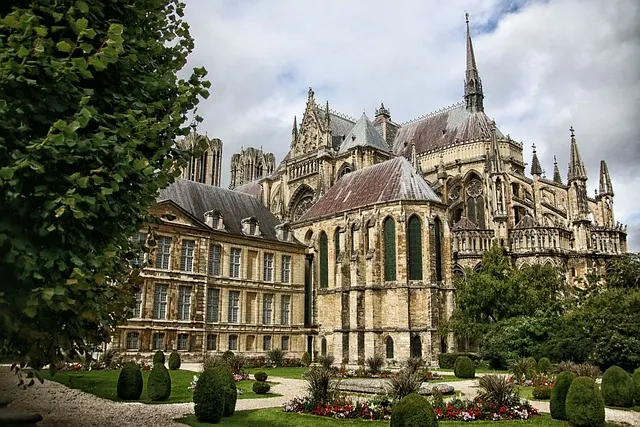Reims , France -The smiling angel & coronation cathedral
When the Romans had conquered almost all of Europe, a small tribe of Franks under a King who was born in Belgium, by the name of Clovis, resisted the Roman rule during the latter half of the 4th century. He engaged the Romans in several battles and united the Frankish tribes to ultimately push the Romans beyond Belgium into Italy. The King was later baptized a Christian in a place called Reims. Upon the Roman ruins, he built a small church. He was said to have been anointed by St.Remi and his reign was the beginning of the Merovingian dynasty. This dynasty carved out a kingdom from Roman rule, which later grew to become what is now known as France.
In those days the French believed that their kingdom could not, for one day, remain without a king. When their king died, the Lord Chancellor would introduce the heir to the throne and proclaim the fact, with the words, “The king is dead, Long live the King”. Thus the tradition of passing governance became eternal and unbroken. In the course of time, the religion and the clergy came to wield great power in French politics and every King had to show his allegiance to the church to gain public acceptance. Thus came into existence a coronation ceremony, performed by the clergy, apart from the traditional practice of passing power, through the official proclamation by the chancellor.
The coronation originally began with a simple ceremony in the church at Reims, where the heir to the throne promised to rule the people justly and also uphold the religion. The bishop then would rub a little aromatic oil brought from the grave of King Clovis on the forehead of the heir aspirant, to anoint and proclaim him as king. In later years it came to be a ceremony which began with unction on the forehead with the holy oil, followed by crowning and the presentation of a scepter. In later years a ring and a scroll were further handed over to the King. The King would then feast with the bishop and march his court to the Palace, to the chime of an 11-ton church bell, and to the silent flutter of the birds freed by the people with the vociferous chant of “Viva Rex in aeternum.”
This church and town which Clovis built were where almost all kings of France with the exception of a few, were crowned The Church was called the cathedral of the Notre Dame de Reims. It was built into a large cathedral which was destroyed by fire in the twelfth century. The church was rebuilt into a cathedral 85 meters tall and has an area of 4800 sq meters. Gothic architecture dominated the façade and the construction was made using hard limestone. It has three portals decorated with arty sculptures of Kings, Bishops, Apostles, Saints, and Angels. High vertical columns with richly carved small sculptures decorate the interior. Large multi-colored stained glass windows adorn the sides just below the roof. The altar where the king was crowned and mass was served was the center stage which is surrounded by exquisite wooden carvings depicting biblical events from the New Testament. Chapels to various saints also find places on the sides and behind the altar. The church possessed more than 3000 statues of which there are about 2300 remaining, beautifying the interior. Prominent among them all is the sculpture of a happy, gentle-looking, smiling angel and of the coronation of Mother Mary which is on the facade of the church.
During the French War of Succession, Joan of Arc who was also called the Maid of Orleans is said to have fought her way through 170 miles of enemy-held territory to break the English siege of Orleans and further liberate this church from their hands. It was here she helped the coronation of King Charles VII put an end to the claims of others to the French throne. During the First World War, the church served as a hospital. The shelling during the war destroyed the roofs of the church. The German commander who ran the expedition, however on seeing the intricate beauty of the church refused commands to destroy the church and spared it from further demolition.
The church was reconstructed again with the support and funds of the American millionaire Rockefeller. The high-rise vertical columns which originally supported a wooden roof that was burnt down during the world war, now support steel and concrete. The flooring has a unique mosaic design and the stained glass windows are another wonder. They are masterpieces in reconstruction. It makes famous the work of the world-renowned artist Marc Chagall who used medieval techniques in glassmaking and design during its reconstruction.
Having looked around and spent almost more than four hours admiring the beauty and architecture I was awestruck. The history attached to the cathedral beginning from the Romans, King Clovis, Joan of Arc, and the kings of France left me spellbound. But I was bemused when I remembered that the French, who did not want a day without being protected by a king, revolted violently to overthrow the monarchy forever and end the religious tradition of the coronation of the kings.
Ironically I was amused at their conduct in accepting Napoleon Bonaparte who in fine French tradition called upon the bishop of Reims to consecrate him as the first Emperor of France. I could not comprehend their national fervor as well as that of the Lords and noblemen of the revolution, who were silent witnesses permitting him to revive the ritual and ceremony of unction, anointing, pledge, crowning, as well as the presentation of the scepter, ring and scroll in the presence of the Pope.
This ceremony was, however, not in the cathedral at Reims but in Notre Dame de Paris, the largest cathedral in the world.
Significantly, Kings did come and Emperors did go. Maybe all traditions began and got changed forever, but the church of Notre Dame de Reims still remains with the glorious sculpture of “the crowning of Virgin Mary ” magnificently adorning the central portal, proclaiming a new meaning to the word “coronation church”. Maybe that is why, I guess I enjoyed, the evergreen smile on the beautiful angel in the right façade which keeps fascinating the world forever and winning hearts for all times to come.







